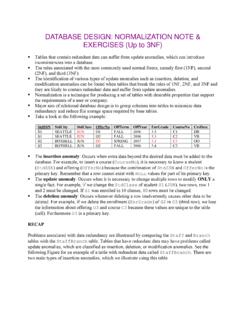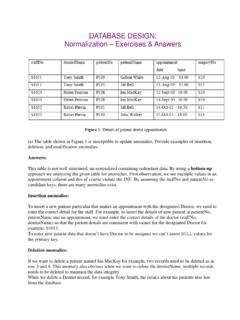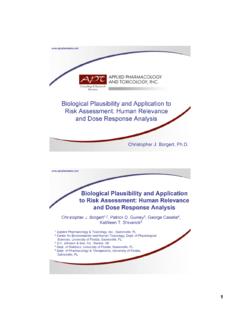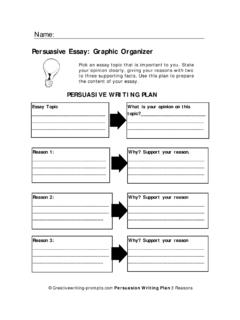Transcription of Developing Entity Relationship Diagrams
1 Developing Entity Relationship Diagrams (ERDs) Introduction This document seeks to give expanded explanation and examples of how to produce Entity Relationship Diagrams . It is based on material adapted from a previous CQU course web page ( ) and material used in Lecture 7 for COIS20025 in Term 2, 2006. Why ERDs? Entity Relationship Diagrams are a major data modelling tool and will help organize the data in your project into entities and define the relationships between the entities. This process has proved to enable the analyst to produce a good database structure so that the data can be stored and retrieved in a most efficient manner. By using a graphical format it may help communication about the design between the designer and the user and the designer and the people who will implement it. Components of an ERD An ERD typically consists of four different graphical components: 1. Entity . A data Entity is anything real or abstract about which we want to store data.
2 Entity types fall into five classes: roles, events, locations, tangible things or concepts. employee, payment, campus, book. Specific examples of an Entity are called instances. the employee John Jones, Mary Smith's payment, etc. 2. Relationship . A data Relationship is a natural association that exists between one or more entities. Employees process payments. 3. Cardinality. Defines the number of occurrences of one Entity for a single occurrence of the related Entity . an employee may process many payments but might not process any payments depending on the nature of her job. 4. Attribute. A data attribute is a characteristic common to all or most instances of a particular Entity . Synonyms include property, data element, field. Name, address, Employee Number, pay rate are all attributes of the Entity employee. An attribute or combination of attributes that uniquely identifies one and only one instance of an Entity is called a primary key or identifier.
3 Employee Number is a primary key for Employee. Figure 1 is a very simple, example ERD with each of the four components labelled. Figure 1 A simple, example ERD Different ERD styles As with many data modelling tools there are a number of different styles used to create ERDs. This web page ( ) lists four different styles for caradinalities. The style used in this course will be the one labelled "Information Engineering". One Methodology for Developing an ERD Typically you will start with a case study or perhaps a logical model of the system to be developed. This document will demonstrate how to use the following process to convert that information into an ERD. The process has ten steps: 1. Identify Entities Identify the roles, events, locations, tangible things or concepts about which the end-users want to store data. 2. Find Relationships Find the natural associations between pairs of entities using a Relationship matrix.
4 3. Draw Rough ERD Put entities in rectangles and relationships on line segments connecting the entities. 4. Fill in Cardinality Determine the number of occurrences of one Entity for a single occurrence of the related Entity . 5. Define Primary Keys Identify the data attribute(s) that uniquely identify one and only one occurrence of each Entity . 6. Draw Key-Based ERD Eliminate Many-to-Many relationships and include primary and foreign keys in each Entity . 7. Identify Attributes Name the information details (fields) which are essential to the system under development. 8. Map Attributes For each attribute, match it with exactly one Entity that it describes. 9. Draw fully attributed ERD Adjust the ERD from step 6 to account for entities or relationships discovered in step 8. 10. Check Results Does the final Entity Relationship Diagram accurately depict the system data? A Simple Example The above process will be illustrated by working through the following example.
5 A company has several departments. Each department has a supervisor and at least one employee. Employees must be assigned to at least one, but possibly more departments. At least one employee is assigned to a project, but an employee may be on vacation and not assigned to any projects. The important data fields are the names of the departments, projects, supervisors and employees, as well as the supervisor and employee number and a unique project number. Each of the following sections corresponds to one of the stages above. Identify entities In this stage, you look through the information about the system and seek to identify the roles, events, locations, concepts and other tangible things that you wish to store data about. One approach to this is to work through the information and highlight those words which you think correspond to entities. A company has several departments. Each department has a supervisor and at least one employee.
6 Employees must be assigned to at least one, but possibly more departments. At least one employee is assigned to a project, but an employee may be on vacation and not assigned to any projects. The important data fields are the names of the departments, projects, supervisors and employees, as well as the supervisor and employee number and a unique project number. This example is quite simple in that the last couple of lines actually tell you what data is being stored and that makes it somewhat easy to identify the entities. You may notice that "company" has been highlighted. It is not an example of an Entity . A single company will use the system we are designing to keep track of its departments, projects, supervisors and employees. A true Entity should have more than one instance. Our system will probably contain information about multiple employees, supervisors, projects and departments. But it will only contain one instance of a company.
7 Find Relationships In this step the aim is to identify the associations, the connections between pairs of entities. A simple approach to do this is using a Relationship matrix. Which is a fancy name for a table that has rows and columns for each of the identified entities. Table 1 is an example Relationship matrix for the above example. With four entities there are four rows and four columns. Each cell is used to indicate whether or not that combination of entities has an association. Department Employee Supervisor Project Department Employee Supervisor Project Table 1 An example Relationship matrix. Having created your Relationship matrix you should now go through each cell and decide whether or not there is an association. For example, the first cell on the second row is used to indicate if there is a Relationship between the Entity "Employee" and the Entity "Department". Table 2 is an example Relationship matrix that has been completed for the current example.
8 Department Employee Supervisor Project Department Is assigned Run by Employee Belongs to Works on Supervisor Runs Project Uses Table 2 An example complete Relationship matrix. The names placed in the cells are meant to capture/describe the relationships. So you can use them like this A Department is assigned an employee A Department is run by a supervisor An employee belongs to a department An employee works on a project A supervisor runs a department A project uses an employee Draw Rough ERD Your completed Relationship matrix now contains a list of all the entities and all the relationships between those entities. This is enough information to create a rough ERD. Draw a diagram and: Place all the entities in rectangles Use diamonds and lines to represent the relationships between entities. Obviously, you should lay out the entities so there is no overlap of the relationships.
9 Figure 2 is an example rough ERD that represents the content of Table 2. Figure 2 An example rough ERD Fill in Cardinality In this step we're aiming to identify the number of occurrences of one Entity for a single occurrence of the related Entity . For example, how many supervisors can there be for a single department? How many departments can a single supervisor be associated with? To answer this you can loop through each Entity from our rough diagram and ask the question "how many of this Entity ?" for a single instance of each related Entity ? Here's an example drawing on Figure 2 and the case study described above Supervisor Each department has one supervisor. Department Each supervisor has one department. Each employee can belong to one or more departments Employee Each department must have one or more employees Each project must have one or more employees Project Each employee can have 0 or more projects.
10 The cardinality of a Relationship can only have the following values One and only one One or more Zero or more Zero or one An ERD is modified to show this cardinality by place some extra marks on the line connecting an Entity and a Relationship . Figure 3 summarises the marks/notation used in ERDs to indicate cardinality. Figure 4 is a modified ERD to show the cardinality of the various relations in our example. Define primary keys A primary key is an attribute, or collection of attributes, that can be used to uniquely identify a specific instance. My name, "David Jones", is not a primary key as there are many people with that name. If I was a student at CQU, my student number would be a primary key as each student number uniquely identifies one and only one student. You identify primary keys by examining and evaluating the information about the system. In this example, the following are specified as unique identifiers: Department Name, Supervisor Number, Employee Number and Project Number.





